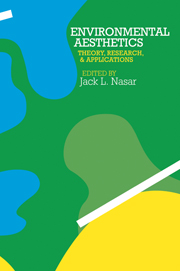Book contents
- Frontmatter
- Contents
- List of figures
- List of tables
- List of contributors and participants
- Acknowledgments
- Preface
- Section I Theory
- Editor's introduction
- 1 Behavioral and perceptual aspects of the aesthetics of urban environments
- 2 Symbolic aesthetics in architecture: toward a research agenda
- 3 Prospects and refuges revisited
- 4 Perception and landscape: conceptions and misconceptions
- 5 Where cognition and affect meet: a theoretical analysis of preference
- 6 The landscape of social symbols
- 7 Open space in cities: in search of a new aesthetic
- 8 Aesthetic perception in environmental design
- Section II Empirical studies
- Section III Applications
- References
- Index of authors
- Subject index
2 - Symbolic aesthetics in architecture: toward a research agenda
Published online by Cambridge University Press: 05 September 2013
- Frontmatter
- Contents
- List of figures
- List of tables
- List of contributors and participants
- Acknowledgments
- Preface
- Section I Theory
- Editor's introduction
- 1 Behavioral and perceptual aspects of the aesthetics of urban environments
- 2 Symbolic aesthetics in architecture: toward a research agenda
- 3 Prospects and refuges revisited
- 4 Perception and landscape: conceptions and misconceptions
- 5 Where cognition and affect meet: a theoretical analysis of preference
- 6 The landscape of social symbols
- 7 Open space in cities: in search of a new aesthetic
- 8 Aesthetic perception in environmental design
- Section II Empirical studies
- Section III Applications
- References
- Index of authors
- Subject index
Summary
Introduction
One of the fundamental goals of design has always been the aesthetic one-the creation of “delightful” rooms, buildings, townscapes, and landscapes. In attempting to understand the nature of the aesthetic experience, a number of people (e.g., Santayana, 1896) have found it useful to distinguish among sensory, formal, and symbolic interactions between people and their built environments. Sensory aesthetics is concerned with the pleasurableness of the sensations received from the environment. It involves the arousal of one's perceptual systems, is multidimensional, and results from the colors, odors, sounds, and textures of the environment. Formal aesthetics in architecture is concerned primarily with the appreciation of the shapes, rhythms, complexities, and sequences of the visual world, although the concepts can be extended to the sonic, olfactory, and haptic worlds. The appreciation of the associational meanings of the environment that give people pleasure is the subject matter of symbolic aesthetics.
The systematic, empirical, and often experimental study of aesthetics has been under way since the pioneering work of Fechner (1876). This research has focused mainly on the formal issues of pattern perception, sequential experiencing of vistas, definition of complexity and simplicity, and form empathy. There are many limitations to this research, but it has yielded a number of positive, if controversial, statements on formal aesthetics (e.g., Arnheim, 1977; Kepes, 1944). The research has not, however, yielded much in attaining an understanding of symbolic meanings, the importance of these meanings to people, or the enjoyment that people derive from them.
- Type
- Chapter
- Information
- Environmental AestheticsTheory, Research, and Application, pp. 11 - 26Publisher: Cambridge University PressPrint publication year: 1988
- 23
- Cited by



